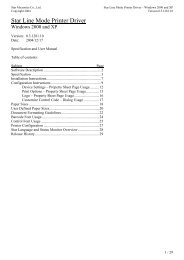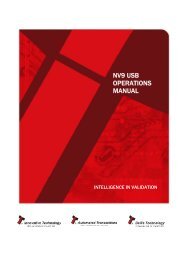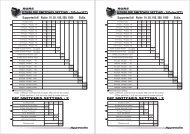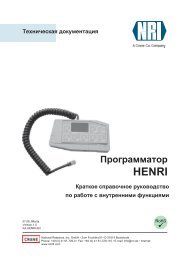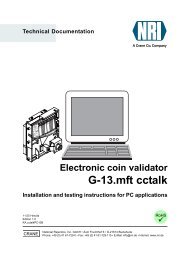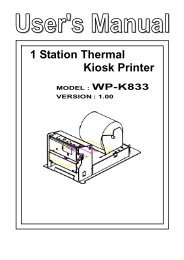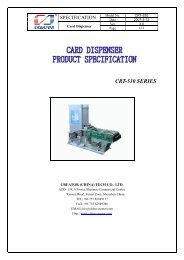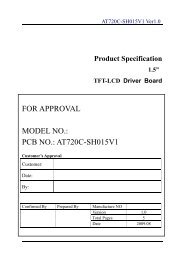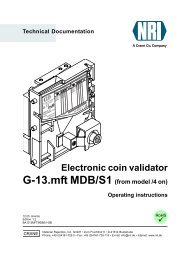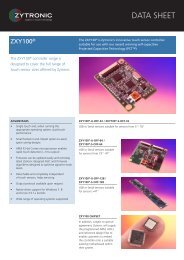Technisches Manual EMP 900
Technisches Manual EMP 900
Technisches Manual EMP 900
Create successful ePaper yourself
Turn your PDF publications into a flip-book with our unique Google optimized e-Paper software.
Technical <strong>Manual</strong> <strong>EMP</strong> 8x0.00/04/13/14 v6<br />
wh Münzprüfer Berlin GmbH, Germany<br />
3.10.2. Coin Jam<br />
After the acceptance of a coin the light barriers are still monitored for 20<br />
sec. (not applicable for battery-operated units). If a coin is identified<br />
within the acceptance channel, without having been passed through the<br />
measuring system in a correct way, a manipulation is noticed (coin on a<br />
string). The coin selector is able to signal this strimming attempt via the<br />
parallel interface to the machine. The coin output line or a combination<br />
of coin output lines, via the strimming is reported to the machine, can<br />
be freely chosen and programmed ex factory.<br />
The strimming information is transmitted with an impulse width that can<br />
be set separately to distinguish it from a normal coin pulse. The<br />
machine is able to distinguish between coin-on-a-thread detection and a<br />
normal receipt signal, as it can recognise the different width and (or)<br />
identify a combination of simultaneously arranged coin output lines. The<br />
default setting for the strimming information is an impulse width of 200<br />
ms.<br />
The message "coin-on-a-thread" is also transmitted via serial SCI, MDB<br />
and ccTalk interface (see chapter 4.2 and 4.3).<br />
If a coin is still identified in the light barrier after 200 ms have passed,<br />
the information will be repeated. During that time, no coin can be<br />
accepted.<br />
If the measuring system identifies a coin, but measuring is concluded<br />
via “timeout” instead of the correct measuring procedure (coin leaves<br />
coin selector passing the receipt light barrier or the return), this will be<br />
interpreted as “coin jamming”.<br />
Via the parallel interface, the coin selector can give a signal for coin<br />
jamming to the machine. The customer can choose any of the coin<br />
output channels or a combination of channels through which coin<br />
jamming will be signalled. The information is emitted with an impulse<br />
width that can be set separately to distinguish it from a normal coin<br />
pulse. The machine is able to distinguish between coin jamming and a<br />
normal receipt signal, as it can recognise the different width and (or)<br />
identify a combination of simultaneously arranged coin output lines.<br />
The message "coin jam" is also transmitted via serial SCI, MDB and<br />
ccTalk interface (see chapter 4.2 and 4.3). The serial interface also<br />
allows the position of the coin jam to be discriminated:<br />
- Coin jam 1 (in the measurement system)<br />
- Coin jam 2 (between measurement system and reject light barrier),<br />
only option /R<br />
- Coin jam 3 (between measurement system and acceptance light<br />
barrier)<br />
- Coin jam 4 (in the acceptance light barrier)<br />
- Coin jam 5 (not possible with the <strong>EMP</strong> 800 v6)<br />
- Coin jam 6 (in the reject light barrier) only option /R<br />
If a coin is still identified in the light barrier after 200 ms have passed,<br />
the message will be repeated. During this time, coin acceptance is<br />
blocked.<br />
version 1.40<br />
page 30/53 subject to technical modification <strong>EMP</strong>8x0.00/04/13/14 v6



